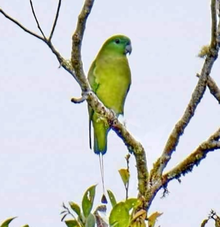| Mindanao racket-tail | |
|---|---|

| |
| Conservation status | |
 Near Threatened (IUCN 3.1) | |
| Scientific classification | |
| Domain: | Eukaryota |
| Kingdom: | Animalia |
| Phylum: | Chordata |
| Class: | Aves |
| Order: | Psittaciformes |
| Family: | Psittaculidae |
| Genus: | Prioniturus |
| Species: | P. waterstradti |
| Binomial name | |
| Prioniturus waterstradti Rothschild, 1904 | |
The Mindanao racket-tail (Prioniturus waterstradti) is a species of parrot in the family Psittaculidae. It is endemic to Mindanao in the Philippines. It was previously conspecific with the Luzon Racket-tail. Two subspecies are recognized: the nominate waterstradti in the south-east, and malindangensis in the west. Its natural habitat is tropical moist montane forests. It is becoming rare due to habitat loss and trapping for the pet trade.
Description and taxonomy
EBird describes the bird as "A medium-sized parrot.The two central tail feathers have extended shafts ending in a racket shape. Green overall, darker on the back and paler below, with deeper green on the head and a blue face. Occurs together with Mindanao lorikeet, but is larger and lacks the red face and bill. Voice includes various nasal squeals and a harsh, metallic 'ra-geek!' often in flight." Known to fly low over the forest.
Subspecies
Two subspecies are recognized
- P. w. waterstradti – Found in the south-east Mindanao; browner mantle
- P. w. malindangensis – Found in the west Mindanao; paler blue on crown and face
Ecology and behavior
This species has no studies on its diet and breeding. It is pressumed to follow a typical racquet tail diet that includes berries, seeds, and nuts. Like all other racket-tails, they are cavity nesters. Not much else is known about its breeding habits and diet.
Habitat and conservation status
It inhabits tropic moist montane forest at 820–2,700 m, but it has been recorded as low as 450 m.
IUCN has assessed this bird as near threatened with its population being estimated as 3,300 mature individuals. Despite this fairly low number and limited range, it is said to be locally common in its range. Montane forest is less under threat than lowland forest. Forest loss may represent a threat but it is not thought to have a significant impact within this species's alititudinal range. Many parrots in the region are affected by trapping for trade, but its impacts upon this species are not known.
It is recommended to gather data on the impacts of international and national trade. Undergo surveys to have a better population estimate. Calculate rates of forest loss within its altitudinal and geographic range using satellite imagery and remote sensing techniques. Effectively protect habitat at key sites,
References
- ^ BirdLife International (2016). "Prioniturus waterstradti". IUCN Red List of Threatened Species. 2016: e.T22684960A93052543. doi:10.2305/IUCN.UK.2016-3.RLTS.T22684960A93052543.en. Retrieved 11 November 2021.
- "Mindanao Racquet-tail". Ebird.
- Allen, Desmond (2020). Birds of the Philippines. Barcelona: Lynx and Birdlife International Field Guides. pp. 226–227.
- Collar, Nigel; Boesman, Peter F. D. (2020). "Mindanao Racquet-tail (Prioniturus waterstradti), version 1.0". Birds of the World. doi:10.2173/bow.mirtai1.01. ISSN 2771-3105.
| Tribus: Psittaculini | |
|---|---|
| Genus | (extinctions: † indicates a species confirmed to be extinct, ₴ indicates evidence only from sub-fossils) |
| Psittinus | |
| Psittacella | |
| Geoffroyus |
|
| Prioniturus | |
| Tanygnathus | |
| Eclectus | |
| Psittacula |
|
| incertae sedis (probably Psittaculini) |
|
| Taxon identifiers | |
|---|---|
| Prioniturus waterstradti | |
This article relating to parrots is a stub. You can help Misplaced Pages by expanding it. |